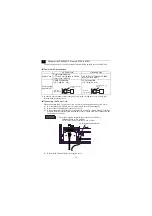
1
System Design
•
Do not create PS-G touch panel switches that could possibly endanger the safety of personnel or
equipment. A malfunction of the PS-G unit, its I/O unit(s), cable(s), or other related equipment can
cause unexpected output signals, leading to a serious accident. Be sure to design all important
machine operation switches so they are operated via a separate control system, and not via the PS-G.
•
Do not create PS-G touch panel switches to control machine safety operations, such as an
emergency stop switch. Install these switches as separate hardware switches, otherwise severe
bodily injury or equipment damage can occur.
•
Be sure to design your system so that a communication fault between the PS-G and its host
controller will not cause equipment to malfunction. This is to prevent any possibility of bodily
injury or equipment damage.
•
Do not use the PS-G as a warning device for critical alarms that can cause serious operator injury,
machine damage or can halt system operation. Critical alarm indicators and their control/activator
units must be designed using stand-alone hardware and/or mechanical interlocks.
•
Do not use the PS-G with aircraft control devices, aerospace equipment, central trunk data
transmission (communication) devices, nuclear power control devices, or medical life support
equipment, due to these devices’ inherent requirements of extremely high levels of safety and
reliability.
•
Be sure to use redundant and/or failsafe system designs to ensure adequate levels of system
reliability and safety when using the PS-G with transportation vehicles (trains, cars and ships),
disaster and crime prevention devices, various types of safety equipment, non-life support related
medical devices, and other similar equipment.
•
After the PS-G unit’s backlight burns out the touch panel is still active, unlike the PS-G unit’s
“Standby Mode”. If the operator fails to notice that the backlight is burned out and touches the
panel, a potentially dangerous machine operation error can occur. Therefore, do not create PS-G
unit touch panel switches that may cause injury and/or equipment damage.
If your PS-G unit’s backlight suddenly turns OFF, use the following steps to determine if the
backlight is actually burned out.
1) If the PS-G unit’s “Backlight Control” is not set and the screen has gone blank, your backlight
is burned out.
2) If the PS-G unit’s “Backlight Control” is set to Standby Mode and the screen has gone blank,
and touching the screen or performing another input operation does not cause the display to
reappear, your backlight is burned out.
Handling
•
Do not modify the PS-G unit. Doing so may cause a fire or an electric shock.
•
Do not operate the PS-G in an environment where flammable gases are present, since it may
cause an explosion.
Wiring
•
To prevent an electric shock be sure to disconnect your PS-G unit’s power cord from the power
supply before wiring the PS-G.
•
Do not use voltage beyond the PS-G unit’s specified range. Doing so may cause a fire or an
electric shock.
Maintenance
•
Do not connect or disconnect Host and PS-G unit communication cables while the PS-G is turned
ON.
•
The PS-G uses a lithium battery for backing up its internal clock data and the battery may explode
if it is replaced incorrectly. When replacement is required, use a Pro-face-designated replacement
or an equivalent product.
Essential Safety Precautions
Содержание PS-3600G Series
Страница 1: ...PS 3600G Series Installation Guide...



































